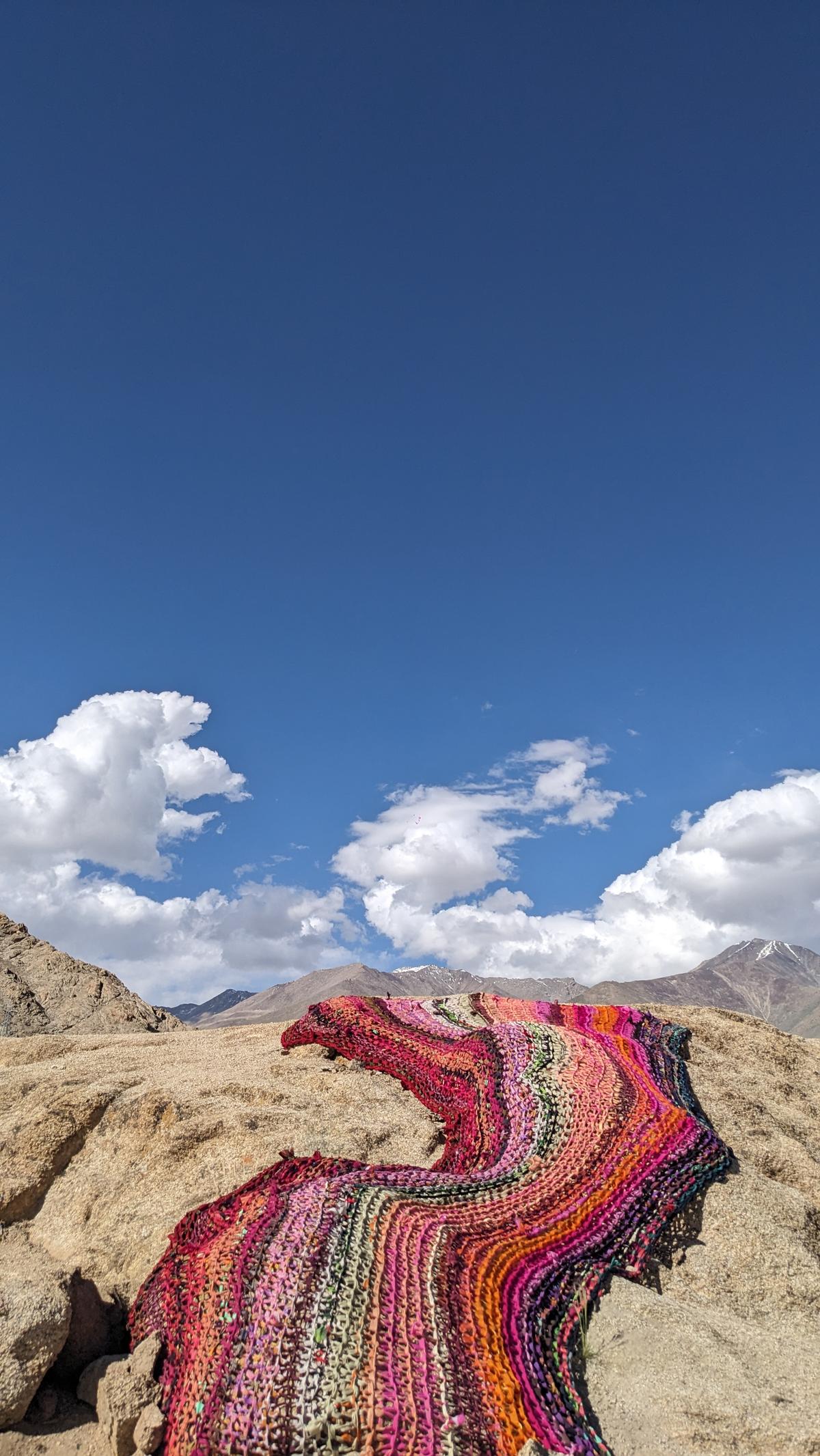[ad_1]
A carpet of fabric in a gradation of red, brown, and maroon spreads across a dirt road leading up to a barren mountain range. Close by, a cross-section of land lights up in blue fluorescence at night. If the last edition of sā Ladakh, South Asia’s highest contemporary land art festival, is anything to go by, interactive public art has found an effective format in the country: imagine art at an altitude of 3,500 metres.
As you read this, bamboo pillars are being erected in the 22-acre Disko Valley Bike Park in Leh, one of the highest in the country, as it prepares for the festival.

Here, Ladakh is not only the host but the subject too. This year’s edition, titled The Future of Immersive Land Art / Immersive Land Art and the Future, hosts site-specific art installations and sculptures crafted from locally sourced, discarded and renewable materials, with active participation from the local community.
Conceptualised one-and-a-half years ago by Ladakhi rock climber Tenzing ‘Jammy’ Jamyang, Austrian-Sri Lankan interdisciplinary artist Raki Nikahetiya, and Indian spatial designer Sagardeep Singh, the festival is a product of their love for Ladakh and land art .

River of Sweat by Anshu Singh from the last edition
| Photo Credit:
special arrangement
“We all had individual reasons to love Ladakh. Jamyang is from here, Sagar worked here for a long time, and I grew up in Austria around mountain landscapes and visited here often,” says Raki.
Initially, Sagardeep and Raki wanted to collaborate on a land art project within the bike park, and on realising the scale decided to invite others as well.
“We wanted to do something about the environment, culture, and community. We also started thinking about how we can involve more Ladakhi artists, and so Ladakh Arts and Media Organisation joined in.” The cohort quickly expanded from three artists to 40 artists. While being a platform that spotlights Ladakhi artists who get little exposure outside, the project also aims to bring international attention to climate change and the awareness around it, not as activism but as “optimism.” Raki explains, “The idea is not to point fingers at whether one is doing it right or wrong, but to take a collaborative approach of artists reacting to a changing environment.”

So, the question of how one can live and create sustainability forms the cornerstone of their body of work. The question posed to the artists was how they would imagine or engage with a landscape, so vast, in times of a changing environment. The 2024 edition features works by renowned artists such as Manisha Gera Baswani, Kunzes Angmo, Tsetan Angmo, Zarina Parveen, Kundan Gyatso, Stanzin Tsepel, Tsering Youdol, Urgain Zawa, Li Actuallee, Viola Borden, Doyel Joshi, Neil Ghose Basler, Omaggio Performing Company, Margherita Moscardini, Raghav and Ansh Kumar, Angelina Kumar, Ramon De Marco, Ikshit Pande, Jasmeet Dhillon, and Laurent Ziegler.
Senior renowned artists like Minerva Cuevas, Shilpa Gupta, and Samson Kambalu, Agnieszka Kurant, Christian Robert-Tissot, Eva Schlegel, Grazia Toderi, and Erwin Wurm will also exhibit their work.
Jigmet Angmo’s untitled work from the last edition
| Photo Credit:
special arrangement
In an interesting collaboration with Austrian public arts institution, Museum in Progress, flags that constantly change and expand at different locations within the space will track the movement of the wind. Another collaboration with Royal Enfield is an artist residency titled The Himalayan Knot will bring Himalayan communities, local artisans and textile conservationists to preserve pastoral land and its living heritage by spreading awareness around the rich fibre culture of Ladakh. A big part of this year’s festival is hinged on the school outreach programmes.
“It’s a demanding landscape. The main physical challenge is the weather — strong sun, winds, snow, cloudbursts (which is happening more often now). Sometimes, it is also about letting go and trying to adapt according to the situation and learn from the local work as well. Sometimes, the artist comes with a concept, but it changes when it is placed in the space,” says Raki.
A big question that remains with public art is what happens once it is created or displayed. Raki says that each artist is asked to address this question right at the open call stage — “We see how the artwork can go back to the community, like for instance, how reused timber could perhaps be used for the construction of a building. It could also be artwork that can travel and be exhibited elsewhere.” This is also the beauty of contemporary art, as it is sans limit, which encourages every artist to think about the possibilities of the materials used. “The thought is what creates the magic within,” he adds.
For A Fifty Million Years by Raki Nikahetiya from the last edition
| Photo Credit:
special arrangement
How does the viewer prepare for this experience? Raki has a checklist. “You must acclimatise. A 48-hour window is ideal. Once you acclimatise, good footwear, sunscreen, hats, and water. From Leh, it would be a 45-minute walk or 10 minutes by road to the bike park. The best time to visit is from 10am till lunchtime. From 5pm to 6pm, there will be curated walks. It’s art plus exercise!”
sā Ladakh will be open to the public from June 1 to 11 at Disko Valley Bike Park, Leh. School workshops will be on from June 1 to 5. Entry is free for all.
[ad_2]
Source link





